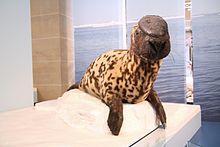Hooded seal
| Hooded seal | |
|---|---|
 |
|
| Scientific classification | |
| Kingdom: | Animalia |
| Phylum: | Chordata |
| Class: | Mammalia |
| Order: | Carnivora |
| Family: | Phocidae |
| Genus: |
Cystophora Nilsson, 1820 |
| Species: | C. cristata |
| Binomial name | |
|
Cystophora cristata (Erxleben, 1777) |
|
 |
|
| Distribution of the hooded seal. Breeding grounds indicated in blue. | |
The hooded seal (Cystophora cristata) is a large phocid found only in the central and western North Atlantic, ranging from Svalbard in the east to the Gulf of St. Lawrence in the west. The seals are typically silver-grey in colour, with black spots that vary in size covering most of the body. Hooded seal pups are known as "blue-backs" because their coats are blue-grey on the back with whitish bellies, though this coat is shed after 14 months of age when the pups molt.
The generic name Cystophora means "bladder-bearer" in Greek, from the species' unusual sexual ornament – a peculiar inflatable bladder on the head of the adult male. This bladder hangs between the eyes and down over the upper lip in the deflated state. In addition, the hooded seal can inflate a large balloon-like sac from one of its nostrils. This is done by shutting one nostril valve and inflating a membrane, which then protrudes from the other nostril.
Adult males are 2.6 metres (8 ft 6 in) long on average, and weigh 300–410 kg (660–900 lb). Sexual dimorphism is obvious from birth and females are much smaller: 2.03 metres (6 ft 8 in) long and weighing 145–300 kg (320–661 lb). The colour is silvery; the body is scattered with dark, irregular marks. The head is darker than the rest of the body, and without marks.
Hooded seals live primarily on drifting pack ice and in deep water in the Arctic Ocean and North Atlantic. Although some drift away to warmer regions during the year, their best survival rate is in colder climates. They can be found on four distinct areas with pack ice: near Jan Mayen Island (northeast of Iceland); off Labrador and northeastern Newfoundland; the Gulf of St. Lawrence; and the Davis Strait (off midwestern Greenland). Males appear to be localized around areas of complex seabed, such as Baffin Bay, Davis Strait, and the Flemish cap, while females concentrate their habitat efforts primarily on shelf areas, such as the Labrador Shelf. Hooded seals are known to be a highly migratory species that often wander long distances, as far west as Alaska and as far south as the Canary Islands and Guadeloupe. Prior to the mid 1990s, hooded seal sightings in Maine and the east Atlantic were rare, but began increasing in the mid 1990s. From January 1997 to December 1999, a total of 84 recorded sightings of hooded seals occurred in the Gulf of Maine, one in France and one in Portugal. From 1996 to 2006, five strandings and sightings were noted near the Spanish coasts in the Mediterranean Sea. There is no scientific explanation for the increase in sightings and range of the hooded seal.
...
Wikipedia

